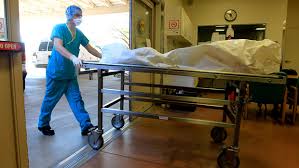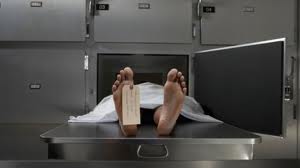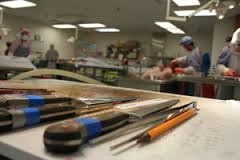Ever been to the morgue?
 No?
No?
Well, like most people, you probably never think of the morgue except during shows like CSI, Bones or Hawaii 5-0.
But the popularity of forensic TV series is social proof that you’re interested in finding out just what goes on behind the autopsy suite’s closed door.
The word autopsy means ‘to examine for yourself’. It’s a medical procedure that sounds simple in principle – taking a look at the outside and inside of a cadaver to establish the cause of death. In practice, a post mortem examination can be highly complicated and time consuming; employing leading-edge scientific expertise.
 There’s three types of PM’s. A hospital autopsy is a non-legal process where the cause of death is known, but the caring physician wants to confirm a specific issue – such as a cancer tumor. A routine autopsy is conducted when the cause of death is not known, but foul play is not suspected. Then there’s a forensic autopsy – the one that’s going to be torn apart in a murder trial.
There’s three types of PM’s. A hospital autopsy is a non-legal process where the cause of death is known, but the caring physician wants to confirm a specific issue – such as a cancer tumor. A routine autopsy is conducted when the cause of death is not known, but foul play is not suspected. Then there’s a forensic autopsy – the one that’s going to be torn apart in a murder trial.
All autopsies follow a standard protocol. It’s the nature of the investigation that determines just how in-depth the procedure gets. The deceased arrives at the morgue and is cataloged with personal details and a registration number. Yes, they really do use toe-tags. The body is then placed in a refrigeration unit and waits its turn for examination. In a busy morgue this can take several days.
Usually two people conduct the autopsy. The pathologist, or medical doctor who is trained in the study of death and disease, is assisted by the Deiner (German word for helper). Often there’s observers present; police officers, students, or technicians who come and go. The length of time quite varies – fifteen minutes to confirm a tumor, two hours routinely, and up to eight for a complicated forensic ordeal.
 External observation can take a good portion of time. The body is removed from its shipping shroud, stripped, photographed, X-Rayed, weighed, measured, and identifiers such as race, age, hair and eye color, markings, abnormalities, as well as evidence of trauma or medical intervention is recorded. In homicide cases, the bulk of the evidence can be recovered in the external exam – clothing perforations, gunshot residue, lacerations, abrasions, hair, fibre, DNA, chemical contamination, or foreign objects. The observations are recorded on notes, diagrams, photos, and verbal dictations.
External observation can take a good portion of time. The body is removed from its shipping shroud, stripped, photographed, X-Rayed, weighed, measured, and identifiers such as race, age, hair and eye color, markings, abnormalities, as well as evidence of trauma or medical intervention is recorded. In homicide cases, the bulk of the evidence can be recovered in the external exam – clothing perforations, gunshot residue, lacerations, abrasions, hair, fibre, DNA, chemical contamination, or foreign objects. The observations are recorded on notes, diagrams, photos, and verbal dictations.
The corpse is placed supine, on its back, on the examining table which is an angled stainless steel tray draining fluids to a disposal sink. A plastic block is placed under the back to elevate the chest and recline the head and arms, making internal operations practical. A Y-incision is sliced from the tip of each shoulder, horizontally to the center of the chest, then vertically down to the pubic area. The skin is scalpeled back in a butterfly pattern accessing the thorax and abdomen, then the ribcage is snipped loose, exposing the upper and lower organs.
 The major ones are removed, weighed, and cross-sectioned – lungs, heart, liver, kidneys, spleen, stomach, and intestines. Tissue sections are exscinded and fluids are extracted – blood, urine, vitreous humor, and digestive contents. These can be of immediate visual interest, or may tell later tales in toxicology and microscopic processing.
The major ones are removed, weighed, and cross-sectioned – lungs, heart, liver, kidneys, spleen, stomach, and intestines. Tissue sections are exscinded and fluids are extracted – blood, urine, vitreous humor, and digestive contents. These can be of immediate visual interest, or may tell later tales in toxicology and microscopic processing.
Cranial examination is the part that most newbies find difficult. The neck is now propped to elevate the head and the scalp is cut from ear to ear, peeled over the face and down the neck, then the skull cap is severed with a vibrating saw. The brain extracts easily and is often preserved in formalin to gel for later sectioning.
 Completion involves returning the organs to the central cavity and sewing-up the incisions before releasing the body to a funeral home. Tissue and liquids are retained for histology and toxicology. In forensic cases, exhibits such as bullets, trace evidence, DNA standards, and clothing are transferred to the crime lab.
Completion involves returning the organs to the central cavity and sewing-up the incisions before releasing the body to a funeral home. Tissue and liquids are retained for histology and toxicology. In forensic cases, exhibits such as bullets, trace evidence, DNA standards, and clothing are transferred to the crime lab.
Often the cause of death is conclusive at autopsy. Occasionally nothing is known until the lab results come in. And sometimes… it’s never determined just why the subject died.
Our scientific understanding of life and death is extensive, but it’s far from perfect.

Hi I would like to know that when an autopsy is performed and only the stomach, liver and blood are examined and the deceased was known to have overdosed and there was no drugs found in the stomach, would it be possible to find the route where the drugs entered the victim, e.g. if toxicology tests were not carried out on the kidneys or the small / large intestine?
Thank you
K Myers
Hi Karen & thanks so much for your interest.
There really is no such thing as a partial autopsy. There’s a universal post mortem procedure which starts with an external exam looking for defects such as needle marks, wounds, etc. Usually there is some indication of the cause of death before the pm starts so the pathologist would be on the lookout for an ingestion point, such as in the case of a suspected overdose. (The basic triangle of death investigation is body – scene – history).
The internal exam starts with a torso – abdominal incision and the removal of all organs; each of which is dissected in a routine manner. The cranial exam is usually the final part. I have never seen an autopsy that focussed on only the stomach / intestine / kidneys. It would be gross incompetence not to examine the entire body and no properly trained pathologist would do that.
Now, it’s an interesting question about point of entry in a drug od. The only time stomach contents would reveal drug evidence would be in the case of prescription pill swallowing (or I suppose the rare case of poisoned food). Most street drug od’s are venous injection or respiratory inhalation, both of which would leave physical evidence in the form of needle tracks or lung sooting. However, the final proof in od cases is through toxicology and blood is by far the best substance for analysis, followed by urine and vitreous humor.
I’m wondering if you have a specific case that you’re referring to? This is interesting as to how your question came to be.
Garry
Any time I hear the word autopsy, I can’t help but think about that short story Stephen King wrote about the guy who was bit by a snake and seemed dead, but he was conscious and freaking out in the morgue because he could hear them getting ready to start an autopsy on him and he couldn’t move or communicate to tell them he was still alive. I know the story is pure fiction but could that really happen, if by some rare fluke you were exposed to some weird toxin that simulated death except it was a really deep coma that you were actually conscious in??
Hi Stacey,
I’ve never heard of a death being mistaken in a place like Canada, but there’s quite an interesting history behind Zombies in the Caribbean and the coma state which is behind the legend so I wouldn’t doubt that it’s happened. Talk about freaky!
There’s a few safeguards in the first world death investigation systems. Usually death is completely obvious – ie. mortis changes; rigor, palor or colour not to mention the smell when they’ve been around for awhile 🙁 There’s also a standard test during the ‘head-to-toe’ examination that a coroner does at the scene. You open an eye and push on it. If there’s any life at all, coma or not, there will be a reaction by the eye. If none – there’re done for.
Also it’s really unlikely an autopsy would be started for a day or so after discovery, not just administratively, but to give the cadaver time to cool off because it’s more practical to do the PM once rigor has passed and the organs have had a chance to solidify. Sounds kinda cold (excuse the pun) but every business has it’s tricks.
Garry
Who pays for the autopsy?
Excellent question, Valerie.
It depends on who requests it. In the case where an MD or the family wants to confirm something like a tumor, it’s paid for by them (or by Medicare if you’re Canadian). In a Coroner’s case, where it’s necessary to fulfill a statutory requirement to determine cause of death, then the province/state/government pays. The other thing is a training autopsy which would be covered by the Med School.
The cost can be $500 for a simple or hospital PM, $1800 – $2000 for a routine coroner’s case plus extras depending on how much toxicology and X-Rays are ordered, and 5 grand and better for a complex forensic autopsy.
Thanks for asking! Garry
Thanks Garry! I didn’t remember seeing it as a covered service under my health insurance. 🙂